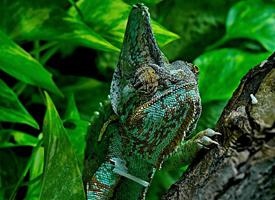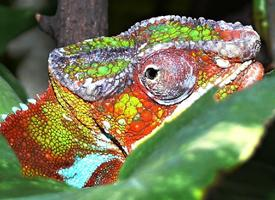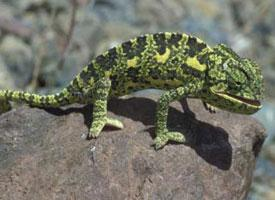
Greutăți și măsuri
| Lungime | de la 30 la 40 cm |
|---|
Date biologice
| Durata de viață | 5 r |
|---|
Descrierea animalului
The Veiled Chameleon (Chamaeleo calyptratus), also known as the Yemen Chameleon, is a striking and fascinating species of chameleon, native to the Arabian Peninsula, specifically Yemen and Saudi Arabia. This species is highly regarded in the pet trade due to its vibrant colors, distinctive physical features, and relatively adaptable nature. The veiled chameleon has garnered attention from reptile enthusiasts and researchers alike, thanks to its unique biological and behavioral characteristics.Physically, the Veiled Chameleon is notable for its impressive size among chameleons, with adults often reaching lengths of up to 60 centimeters (24 inches) for males, and slightly smaller for females. One of the most distinctive features of this species is the casque, a helmet-like structure on top of their heads, which grows taller as they mature and can reach up to several inches in height. This casque is not just for show; it serves a practical purpose by helping to channel dew and rainwater to the chameleon's mouth, aiding in hydration.
The body of the Veiled Chameleon is laterally compressed, facilitating movement through their arboreal habitat, with zygodactylous feet that are perfectly adapted for grasping branches. Their prehensile tail serves as a fifth limb, providing stability and balance as they navigate through vegetation. Another characteristic feature is their independently mobile eyes, which can swivel around to give them a 360-degree view of their surroundings, an invaluable adaptation for spotting predators and prey.
The coloration of the Veiled Chameleon is perhaps what they are most famous for. Although generally seen in shades of green, they can exhibit a wide range of colors including yellows, browns, and blues. These color changes are not just for camouflage as often believed, but are also a means of communication, reflecting their mood, health status, and reactions to temperature and other environmental factors.
Veiled Chameleons are diurnal, meaning they are active during the day. Their diet primarily consists of insects, but they have also been known to consume plant material, which provides them with additional hydration and nutrients. In the wild, their hunting technique is patient and precise, using their long, sticky tongues to capture prey from a distance.
Reproduction in Veiled Chameleons involves distinct courtship behaviors, with males displaying vibrant colors and bobbing motions to attract females. Females lay a large clutch of eggs, which they bury in the ground, and which can take several months to hatch.
In terms of habitat, the Veiled Chameleon naturally inhabits a range of environments from mountainous regions to flatlands, but they are primarily found in areas with abundant trees and vegetation which provide cover and hunting grounds. Despite their adaptability, habitat destruction and the pet trade have put pressures on wild populations, though they are not currently considered endangered.
In captivity, Veiled Chameleons can thrive if provided with a suitable environment that mimics their natural habitat. This includes a spacious enclosure with ample vegetation, appropriate humidity and temperature gradients, and a diet of live insects. They are generally solitary creatures and can exhibit stress if housed with others, so individual housing is recommended.
The Veiled Chameleon represents a fascinating convergence of evolutionary adaptation and ecological niche, making them a subject of interest not only for pet owners but for scientists studying the dynamics of adaptation and survival in changing environments. Their complex behaviors, intriguing physical adaptations, and vibrant colors make them one of the most distinctive and captivating reptiles in the world.
Animale similare
Fotografii noi cu animale
Top 10 animale
- Dolphin gull (Leucophaeus scoresbii)
- Diana monkey (Cercopithecus diana)
- Moustached guenon (Cercopithecus cephus)
- Stone loach (Barbatula barbatula)
- Greek tortoise (Testudo graeca)
- Galápagos tortoise (Geochelone nigra complex)
- Japanese macaque (Macaca fuscata)
- Russian tortoise (Testudo horsfieldii)
- Common flying dragon (Draco volans)
- Galápagos penguin (Spheniscus mendiculus)


